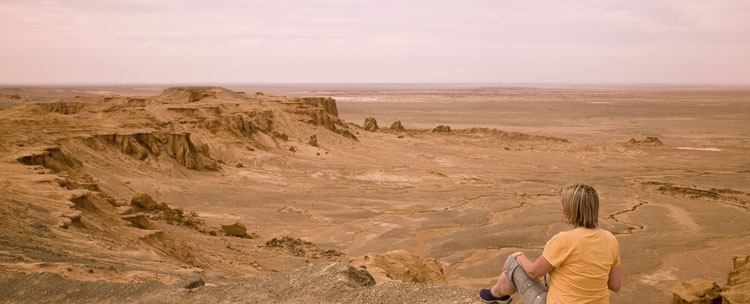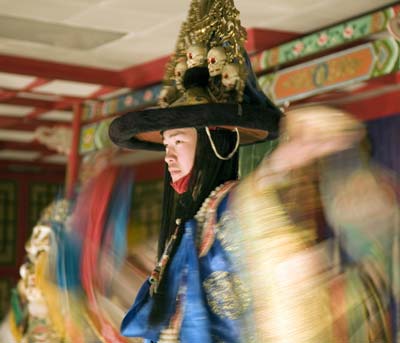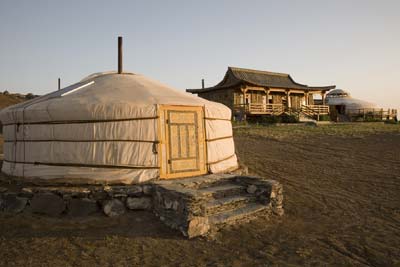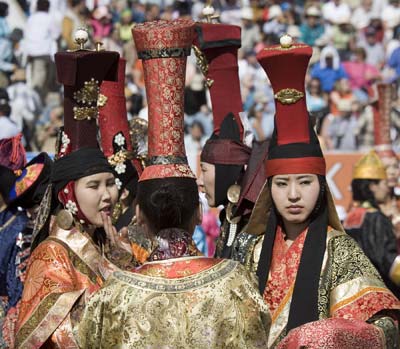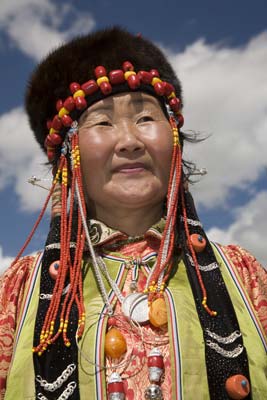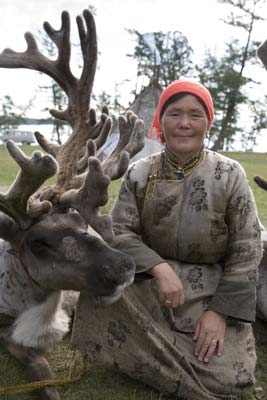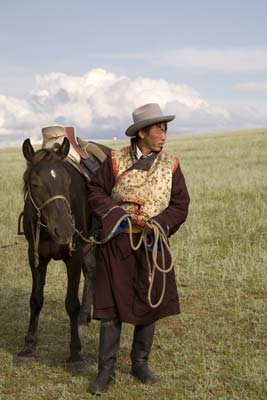Adventure in Mongolia
Story by Dave G. Houser, Photos by Jan Houser, Nogal, NM
It was 7:00 on a crisp July morning in northern Mongolia. Nine of us — veteran travelers — were eager to get under way on a 17-day adventure with Pacific Delight Tours.
For the moment, we were comfortably loaded into a pair of 4WD Russian-made UAZ vans for a 4-hour, 125-kilometer drive from the rustic frontier town of Mörön to Lake Hovsgol, a jewel of a mountain lake geologically related to better-known Lake Baikal in nearby Siberia.
The UAZ was designed during the Cold War for off-road use by the military. Resembling a 1960s VW van on steroids, it is ugly and awkward looking but is said to be ruggedly reliable and simple to maintain. It was its reliability that concerned us as one of the vehicles sputtered to a stop just a few kilometers along the rough, unsigned track that serves as the only route into Lake Hovsgol.
Taking it all in
Our Mongol guide, Darkhad Navaan Baatar (just Baatar to us), and the two drivers removed the passenger seat and engine cover and quickly engaged in repairs.
The impromptu stop gave us a chance at least to assess the surroundings. We were ringed by a vast grassy meadow typical of the great Central Asia steppe, one garlanded with wildflowers — gentian, larkspur and edelweiss prominent among them. The chill air was redolent with the pleasant smell of sage and wild thyme.
To the north, the Erchimiin mountain range caught our attention, fringed along its base by a forest of Siberian larch. The treeless summits, bathed in early sunlight, shimmered in soft shades of gold and crimson. It was a majestic morning, and it set us abuzz with enthusiasm just to be in Mongolia.
Repairs to the UAZ were soon completed and we were excited to be on the move again in the land so often described as one of the world’s last frontiers for real adventure travel.
Those who haven’t kept abreast of current geography may be thinking in terms of Inner and Outer Mongolia. The former, like Tibet, has pretty much lost its identity as an autonomous region of China. So it is the former Outer Mongolia, now simply Mongolia, that was the focus of our travels.
Even without Inner Mongolia, it is a huge landmass — nearly four times the size of France and twice larger than Texas — and features some extraordinary terrain: rugged mountains up to 4,300 meters high, rolling steppes and the awesome Gobi Desert.
Our jostling journey to Lake Hovsgol was rendered almost inconsequential by the stunning landscape, an undulating carpet of green studded by outcroppings of rock and grazed by herds of horses, yaks, goats and sheep.
We saw fat marmots dive for their dens as we bounced past and families of cranes dancing across the steppe on long, delicate legs. Pausing at a salt lake named Erkhel Nuur, we observed a host of waterfowl and a number of lovely white swans that took flight from the shore below us.
Atop a high ridge overlooking the serpentine Egiin River, the sole outflow from Lake Hovsgol, we entered Khövsgöl Nuur (Hovsgol Lake) National Park, a vast reserve of 838,000 hectares established in 1992 to protect the lake.
Passing the village of Khatgal at the lake’s southern tip, we made our way another 20 kilometers up into the mountains along the western shore, crisscrossing rocky creek beds, to arrive at last at Dalai Tur Ger Camp, our home for the next three days.
Camp life
The lakeside camp, situated no more than 50 meters from the water’s edge, was a quiet, cool and comfortable retreat that invited us to lay back and unwind from the rigors of our long airline flights and the bone-jarring ride from Mörön. It consisted of 14 gers and a dining room plus a communal shower house, a sauna and toilets.
A ger (pronounced “gair”) is normally intended to be highly portable, but tourist versions are anchored to wooden platforms. Ours contained a small wood stove (much needed during evenings here), a pair of thinly padded beds, a storage chest and a table with chairs. There was an electric light powered by a generator that operated from 8 to 11 nightly.
A large wood-burning stove in the shower house created the heat — mornings and evenings — for hot showers and the sauna. Many Mongolian ger camps, including one we visited later in the Gobi Desert, are now utilizing solar and wind power.
The Dalai camp is a family operation with a platoon of smiling youngsters (most with minimal English language skills) who were always eager to provide for our every need. We enjoyed three meals a day of surprising quality and variety — far better, in fact, than our Lonely Planet and Bradt guidebooks would have had us believe.
All this said, however, it should be understood that a ger camp stay is in a sense camping out, sans many of the modern conveniences we take for granted. But we came with that well in mind, eager to experience a unique and simple lifestyle that has endured over many hundreds of years — and we loved every minute of it.
Unique experience
We spent our days hiking and horseback riding along the lakeshore while others hired a boat at a neighboring camp or tried their luck at fishing. The lake is loaded with perch, grayling, sturgeon and a long list of fish we’d never heard of.
For the less sensible, there’s yak riding or even swimming in the crystal clear but still frigid waters of Lake Hovsgol.
The most interesting of our experiences was a visit to the nearby camp of a Tsaatan family. Popularly known as “reindeer people,” they are similar to Nordic Lapps and live most of the year deep in the forests to the north. They come down during the summer to graze their herd on the grassy shores of Lake Hovsgol and to engage in a bit of enterprise, selling handmade woolen items and carvings fashioned from reindeer horn and bone.
The family members were shy but welcomed us warmly into their tepee-style tent, where the lady of the “house” was boiling reindeer milk to make yogurt and cheese, staples of the Tsaatan diet. There are only a few hundred Tsaatan in existence, so this was a truly rare moment of cultural exchange. To encounter them otherwise would involve an arduous week-long trek by horseback.
Our visit to the national capital and Mongolia’s largest city, Ulaan Baatar (population around 1,000,000), was planned to coincide with the annual Naadam Festival, July 11-13. This is the biggest event of the year for locals and visitors alike.
Something of a nomad Olympics featuring the country’s three traditional sports — wrestling, archery and horse racing — it is also part fair and family reunion. 2006 celebrated the “800th Anniversary of the Great Mongolian State,” promising an even grander and more colorful pageant than usual, and we could feel it in the air when we checked in at the 4-star Ulaanbaatar Hotel near the city center, its lobby buzzing with foreign visitors and government dignitaries.
Opening ceremonies for Naadam began about 9 a.m. with a noisy and riotously colorful ceremony outside the State Parliament House at Sukhbaatar Square near our hotel. A military band in bright uniforms played stirring march music as hundreds of men dressed in Chinggis-style warrior outfits paraded menacingly around the square, swarming away to the National Stadium to kick off opening ceremonies at 11 a.m.
The big, bowl-shaped stadium was overflowing with more than 40,000 spectators. There were athletes, soldiers, monks and musicians plus marching ensembles representing the country’s 20 ethnic groups, each attired in its own custom finery. Nowhere else in the world have we seen such a spectacularly colorful display of traditional dress.
Unless you have a compelling interest in the traditional sports featured, you may want to limit your spectating time. And, since event schedules are rarely posted (or followed if they are), a good guide is essential to knowing where to be and when. But by all means do not miss a minute of the opening ceremony.
Ulaan Bataar
Whether or not you travel in Mongolia independently or with a group such as ours, you’ll invariably spend some time in Ulaan Bataar (“UB” will do for visitors). So here’s a brief rundown on some of the things you should know about the “big city.”
UB sprawls across a wide valley flanked by mountains with the River Tuul meandering through it, making for an attractive setting. But the metropolis itself is a mix of drab Soviet-era highrises and newer glass-and-steel creations that combine in a sort of eclectic jumble.
It is not a charming city, but it is functional and definitely is the place to be for arranging services and medical care, phoning (our new Mobal World Phone worked splendidly here), e-mailing, shopping, dining and enjoying museums and entertainment.
Museums worth a visit include the National Museum of Mongolian History, featuring an outstanding collection of costumes, hats and jewelry representing most of the country’s ethnic groups. There’s also an excellent exhibit tracing the development of the Mongol empire.
The Museum of Natural History will give you some background on the famous dinosaur digs in the Gobi, and the Zanabazar Museum of Fine Arts is the country’s leading repository of paintings, carvings and sculptures, including many by the revered 17th-century Buddhist sculptor Zanabazar.
Tibetian Buddhism is the predominant religion in Mongolia and it has enjoyed a renaissance in the aftermath of decades of suppression by the Soviets. For a glimpse of Buddhist life here, you should visit Gandantegchinlen Monastery.
The highlight of this temple complex, built in the late 19th to early 20th centuries, is Megjid Janraisag Temple, housing a towering 25-meter-high, 20-ton gold-plated Buddha statue. At 10 a.m. each day, visitors can witness a rather moving prayer ceremony carried out by resident monks.
Choijin Lama Monastery, near the city center, was built in 1908 for the brother of Mongolia’s Living Buddha, Bogd Khaan. Although badly in need of some restoration work, this is a classic and quite lovely example of a monastic complex of the time and one of the few that survived Soviet demolition. Now a museum, it displays a fine collection of Buddhist relics, paintings and ritual tsam masks and costumes.
Much like in Bali and other parts of Indonesia, traditional music and dance is vital in the lives of many Mongolians, and it is regularly performed at several venues in the city and throughout the country. It is imperative that you take in one or more of the cultural shows performed by groups such as the Tumen Ekh Song & Dance Ensemble or the Mongolian National Song & Dance Academic Ensemble, both of which perform nightly during the Naadam Festival.
You’ll see outstanding performances of the unique Mongolian throat-singing known as khoomi, orchestral renditions featuring the distinctive 2-stringed horse-head fiddle (morin khuur), traditional and modern dances, and lithe young contortionists who twist themselves into pretzels right before your eyes.
If you prefer to be more actively involved in your nightlife, there are a number of reasonably up-to-date discos and clubs.
And UB boasts a surprising variety of good restaurants, all moderately priced by world standards ($5-$12 for lunch, $8-$17 for dinner). Enjoy an excellent choice of tandoori and other Indian dishes at Hazara or go for a thick, juicy steak at El Toro.
Silk Road is good for ribs, chicken and pasta, plus there’s a nice view of Choijin Lama Monastery from the shaded verandah. Most tour groups take in this one; otherwise, you’ll need a cab.
The Seoul Restaurant out by the stadium is justly famous among visitors and locals alike for its Korean buffet.
Aside from the requisite souvenirs, shopping in Mongolia is best confined to cashmere products — for which the country is renowned. Cashmere House (#5 Peace Ave., a couple of blocks west of Sukhbaatar Square) offers a wide selection of top-quality sweaters, gloves and rugs at surprisingly low prices.
Most visitors make their way at least once to the megasized, multilevel State Department Store. An anachronism from Soviet times, it’s become a tourist attraction in itself, peddling just about everything you can imagine.
On the third and fourth floors you’ll find the city’s best selections of souvenirs, including arts and handicrafts and authentic traditional clothing. You too can dress up like Chinggis Khaan or his favorite wife, Borte.
Moving on
Having thoroughly enjoyed the Naadam Festival and our 4-day interlude in UB, we were bound once again for the outer reaches of Mongolia, peering down on a barren patch of the Gobi Desert from the windows of an Aero Mongolia Fokker 50 turboprop.
Our scheduled morning flight finally departed UB mid-afternoon, thanks to a rare rainstorm on the Gobi the night before that saturated the dirt landing strip at Juulchin, which is little more than a colony of ger camps. Ours was the first flight of the day to the Gobi, so it would be up to us to test the stability of the strip.
Some of us became a bit nervous on the approach, as it had begun to rain again. We sighed with relief at a bumpy but apparently normal touchdown, only to be overcome seconds later by a funny sort of sinking feeling — our little Fokker was bogged down, wheel-deep in mud, a good kilometer from the terminal! It was more than obvious to us by then that just “getting there” is part of the adventure involved in touring Mongolia.
We tromped across the soggy taxiway while a fleet of 4WD trucks churned out to the mired craft to collect luggage and some passengers who decided to stay put. Bags in hand, we were soon ensconced in another pair of able UAZ vans slogging along a muddy track bound for Three Camel Lodge, some 30 kilometers to the west.
Luxury in the desert
The Gobi had been enduring drought for four years, so the rain was more than welcome by locals, though conditions didn’t look promising for our visit in terms of getting around to the various sites we hoped to explore.
Our worries were cast aside for the time being, however, as we acquainted ourselves with our unexpectedly luxurious accommodations. Three Camel Lodge is a 5-star camp in every sense of the term.
Set at the base of a stony bluff, its 40-odd gers radiate out from a pair of striking stone lodge buildings that house a restaurant with a sparkling display kitchen; shower and toilet facilities; the Thirsty Camel bar, and a large video/sound-equipped entertainment room.
For all of its style and comforts, the lodge serves as a national model of eco-efficiency, employing wind and solar power to achieve its energy needs and local artisans and materials to craft its buildings, which are erected in strict accordance with the canons of Mongolian Buddhist architecture — without using a single nail.
We learned that Three Camels is the pet project of Nomadic Expeditions, the UB-based tour company that serves as Pacific Delight’s ground operator in Mongolia. As it turned out, our energetic 30-something guide and a top manager with the company, Baatar, was instrumental in the planning and construction of the camp, in its second year of operation.
Baatar never ceased to amaze us, not only with his encyclopedic knowledge of the country but with his world view as well — probably derived from having been educated in Russia and Eastern Europe and from his extensive travel throughout Asia and even the United States.
In keeping with its commitment to sustainable tourism, the lodge is staffed almost entirely by locals; foodstuffs and other supplies are purchased locally, and it has formed a coalition with local government and officials of Gurvansaikhan National Park to help carry out conservation initiatives and wildlife monitoring and protection programs.
Three Camels is a “feel good” place that really did feel good, especially when we returned the next day from slithering and sliding about in the desert on our visit to part of the world’s northernmost network of sand dunes at Moltsog Els. Also on the day’s schedule was the widely publicized Flaming Cliffs of Bayanzag, where American paleontologist Roy Chapman Andrews made a huge discovery of dinosaur skeletons and fossilized eggs back in 1922.
Dinosaurs aside, the rugged red-rock canyons presented a stunning vista, much like those we’ve seen in the American Southwest.
An amazing ending
A break in the weather brought sunshine and blue skies, and in scarcely more than a couple of days’ time the landscape across the Gobi turned green as the scrubby grass and shrubs burst back to life.
On the way to the valley of Yolyn Am in the nearby Saikhan Uul mountain range, we spotted a grazing herd of black-tailed gazelle and more of the twin-humped Bactrian camels like those we rode the day before at a nomad camp near the village of Bulgan Sum.
Yolyn Am is a deep, steep-sided canyon that has become quite the visitor attraction, owing to an ice formation at its narrowest point that survives year-round. It is indeed an unusual experience to climb about on glacier-like ice in the middle of the Gobi Desert — in the middle of July.
As something of a send-off on our final night, the lodge staged a musical performance for us featuring several lodge employees who toted out all of the traditional instruments to amaze us once again with the hauntingly beautiful music of the nomads.
Later, as we strolled back to our ger beneath a full moon and a sky bursting with stars, we agreed that this was the perfect ending to a Mongolia visit that far exceeded our expectations.

